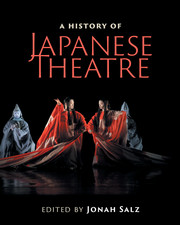Book contents
- Frontmatter
- Contents
- List of figures
- List of tables
- Contributors
- Contributors’ biographies
- Foreword
- Acknowledgments
- Note on Japanese terms
- List of abbreviations
- Timeline
- Editor's introduction
- I Traditional theatres
- Preface to Part I Japanese civilization arises
- 1 Ancient and early medieval performing arts
- Interlude Katari narrative traditions: from storytelling to theatre
- 2 Noh and Muromachi culture
- Interlude Noh and kyogen costumes and masks
- 3 Kyogen: classical comedy
- Interlude Iemoto : the family head system
- 4 Kabuki: superheroes and femmes fatales
- Interlude Nihonbuyo: classical dance
- Interlude Okinawan theatre: boundary of Japanese theatre
- 5 Bunraku: puppet theatre
- Interlude Misemono and rakugo : sideshows and storytelling
- Interlude Kamigata geinō : Kyoto-Osaka style
- Interlude Traditional theatre tomorrow: interview with Takemoto Mikio
- II Modern theatres
- Preface to Part II
- III Arcs and patterns
- IV Theatre architecture
- Preface to Part IV Evolution of Japanese theatre architecture
- V Theatre criticism
- VI Intercultural influences
- Epilogue: Frozen words and mythology
- Further reading
- Index
- References
Interlude Okinawan theatre: boundary of Japanese theatre
from Preface to Part I Japanese civilization arises
Published online by Cambridge University Press: 05 July 2016
- Frontmatter
- Contents
- List of figures
- List of tables
- Contributors
- Contributors’ biographies
- Foreword
- Acknowledgments
- Note on Japanese terms
- List of abbreviations
- Timeline
- Editor's introduction
- I Traditional theatres
- Preface to Part I Japanese civilization arises
- 1 Ancient and early medieval performing arts
- Interlude Katari narrative traditions: from storytelling to theatre
- 2 Noh and Muromachi culture
- Interlude Noh and kyogen costumes and masks
- 3 Kyogen: classical comedy
- Interlude Iemoto : the family head system
- 4 Kabuki: superheroes and femmes fatales
- Interlude Nihonbuyo: classical dance
- Interlude Okinawan theatre: boundary of Japanese theatre
- 5 Bunraku: puppet theatre
- Interlude Misemono and rakugo : sideshows and storytelling
- Interlude Kamigata geinō : Kyoto-Osaka style
- Interlude Traditional theatre tomorrow: interview with Takemoto Mikio
- II Modern theatres
- Preface to Part II
- III Arcs and patterns
- IV Theatre architecture
- Preface to Part IV Evolution of Japanese theatre architecture
- V Theatre criticism
- VI Intercultural influences
- Epilogue: Frozen words and mythology
- Further reading
- Index
- References
Summary
Okinawa developed a culture outside the framework of the Japanese state for much of her history. This was reflected in the dramatic form first created for court performances in the eighteenth century, during a period of “dual subordination” to Japan and China. Kumiodori (kumiudui, “ensemble dance”) and uchininā shibai, performed in “Okinawan language” (uchinā-guchi), developed as distinct genres at the boundary of Japanese theatre, and still function to project and affirm the cultural memory and identity of Okinawans today.
Dual fealty: envoy entertainments
Okinawa is a series of islands lying midway astride the Ryūkyū archipelago, separating Kyūshū from Taiwan. In early Japanese historical records, it was only considered a shadowy primitive border region, referred to as Nantō (Southern Islands). After its period of warring provincial chieftains, Satto (1350–1405) of Chūzan (“Central Land”) became the most influential, initiating a tribunal relationship with Ming China, which acknowledged it as the “Ryūkyū Kingdom,” and eventually succeeded in uniting the archipelago. Between 1404 and 1866, Chinese envoys came twenty-two times on ukwanshin (“crowning ships”) to officially install new Ryūkyūan kings, and stayed as guests of the Ryūkyū court for several months each time. Special performances of music and dance called ukwanshin udui (“dances for crowning ships”) were prepared for welcoming feasts. The study of literature and performing arts was encouraged among the ruling class as a way to educate young Ryūkyūan aristocrats about Chinese learning and culture.
Meanwhile, mainland Japan's southernmost Satsuma domain (present-day Kagoshima prefecture) claimed rights to the Ryūkyū archipelago, sending an expeditionary force there in 1609. The kingdom thus technically came under Satsuma control. The Ryūkyūans began sending envoys to central Japan while remaining a Chinese tributary state. Since court entertainments played important roles for Ryūkyūan dual diplomacy, art and music, rather than swordsmanship, came to be regarded as important accomplishments for court officials. Each time emissaries from Okinawa were sent to Kyoto and Edo (present-day Tokyo) via Satsuma (eighteen times between 1634 and 1850), a prince was chosen as ambassador, assisted by bureaucrats including those in charge of court entertainments. Chinese plays and music, possibly taught by Chinese immigrants to Ryūkyū, along with native Ryūkyūan dances, were included in these ambassadorial shows during the journey to display the expected “foreignness” to mainland Japanese. Such trips also provided opportunities for emissaries to see Japanese performing arts, which were then incorporated into their eclectic repertory.
- Type
- Chapter
- Information
- A History of Japanese Theatre , pp. 150 - 154Publisher: Cambridge University PressPrint publication year: 2016

